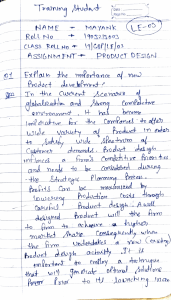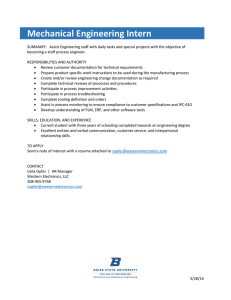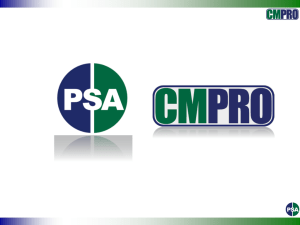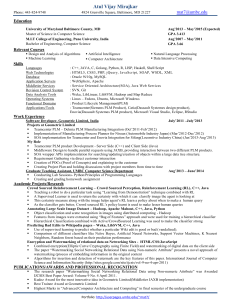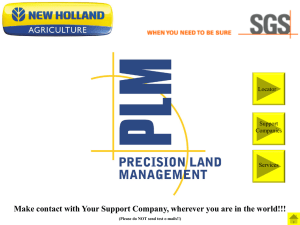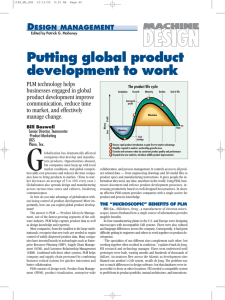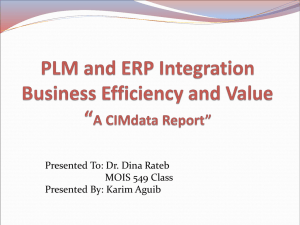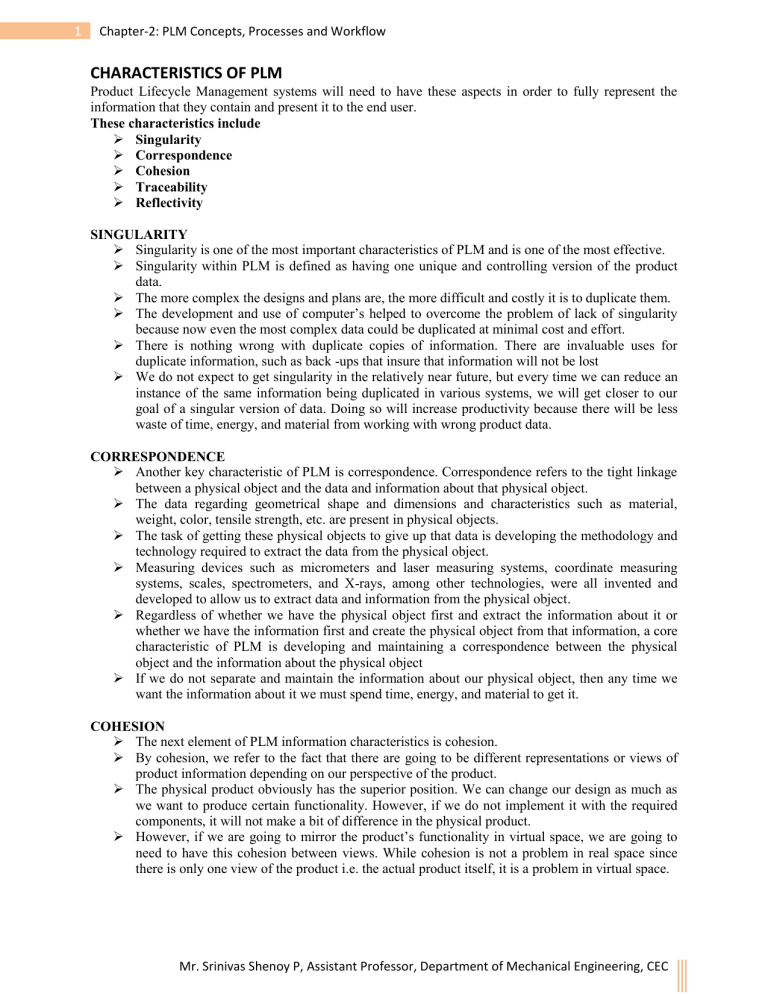
1 Chapter-2: PLM Concepts, Processes and Workflow CHARACTERISTICS OF PLM Product Lifecycle Management systems will need to have these aspects in order to fully represent the information that they contain and present it to the end user. These characteristics include Singularity Correspondence Cohesion Traceability Reflectivity SINGULARITY Singularity is one of the most important characteristics of PLM and is one of the most effective. Singularity within PLM is defined as having one unique and controlling version of the product data. The more complex the designs and plans are, the more difficult and costly it is to duplicate them. The development and use of computer’s helped to overcome the problem of lack of singularity because now even the most complex data could be duplicated at minimal cost and effort. There is nothing wrong with duplicate copies of information. There are invaluable uses for duplicate information, such as back -ups that insure that information will not be lost We do not expect to get singularity in the relatively near future, but every time we can reduce an instance of the same information being duplicated in various systems, we will get closer to our goal of a singular version of data. Doing so will increase productivity because there will be less waste of time, energy, and material from working with wrong product data. CORRESPONDENCE Another key characteristic of PLM is correspondence. Correspondence refers to the tight linkage between a physical object and the data and information about that physical object. The data regarding geometrical shape and dimensions and characteristics such as material, weight, color, tensile strength, etc. are present in physical objects. The task of getting these physical objects to give up that data is developing the methodology and technology required to extract the data from the physical object. Measuring devices such as micrometers and laser measuring systems, coordinate measuring systems, scales, spectrometers, and X-rays, among other technologies, were all invented and developed to allow us to extract data and information from the physical object. Regardless of whether we have the physical object first and extract the information about it or whether we have the information first and create the physical object from that information, a core characteristic of PLM is developing and maintaining a correspondence between the physical object and the information about the physical object If we do not separate and maintain the information about our physical object, then any time we want the information about it we must spend time, energy, and material to get it. COHESION The next element of PLM information characteristics is cohesion. By cohesion, we refer to the fact that there are going to be different representations or views of product information depending on our perspective of the product. The physical product obviously has the superior position. We can change our design as much as we want to produce certain functionality. However, if we do not implement it with the required components, it will not make a bit of difference in the physical product. However, if we are going to mirror the product’s functionality in virtual space, we are going to need to have this cohesion between views. While cohesion is not a problem in real space since there is only one view of the product i.e. the actual product itself, it is a problem in virtual space. Mr. Srinivas Shenoy P, Assistant Professor, Department of Mechanical Engineering, CEC 2 Chapter-2: PLM Concepts, Processes and Workflow TRACEABILITY Traceability is the ability to demonstrate the path of a product’s travel through time and the ability to follow the path back to its origin. The reason why traceability is important is that, we do not start every day with a new product, but instead rely on what we have done the day before to continually progress. The result of a lack of traceability is that we run the risk of wasting time, energy, and material in a number of different ways. First, if we cannot determine which the successful version was and which the unsuccessful version of our previous efforts was, and if we chose an unsuccessful version to build upon, we would eventually realize, after wasting time, energy, and material, that we chose the wrong one. The move into virtual space should greatly improve traceability. The ability to capture information at its source and the ability to find that information when needed will enhance the traceability of products, both in development and in use. PLM must have traceability as a core element. REFLECTIVITY Reflectiveness is directly related to that connects the real space to virtual space and captures data and information from real space into virtual space. In real space, when we change the state of anything, trim a little material off a part, assemble two parts together, erase one line and draw another on a piece of paper, the information changes because it is intrinsically part of the atoms that are impacted by those changes. If we are going to separate that information and create an image of it in virtual space, then we need a mechanism to change the information in virtual space when the corresponding information changes in real space. The whole point of reflectiveness is to allow us to substitute this information for wasted time, energy, and material. If we can examine virtual space when we need information, it will be substantially less costly and time consuming than examining real space. EXTERNAL DRIVERS Scale In order to appreciate the scale of today’s organizations, we need to go back and look at an extended time period to see what changes, if any, have occurred in our organizations over that period of time. The issue we generally face as human beings is that it is sometimes difficult to see change occur as we live it from day to day. It is only when we take a longer view that the elements of change and the magnitude of change come into sharp focus. If we look at the past 30 years, it is difficult not to see the immense changes in scale that have occurred in our organizations. While we have always viewed our large corporations as being large within our society, we really don’t get a handle on the size change unless we do a comparison over the past 30 years. Complexity Not only are organizations getting bigger, but they are producing more and more complex products. What we are looking at here is the number of different products that are offered in the marketplace. The underlying premise is that, with an increase in the number of different products there is an increase in the amount of information about those products that organizations must deal with. If we look at the 1980s compared to the 2000s, we see a number of diverse categories of products and the change in the number of products that are offered in the marketplace in those categories. Cycle times The next element of fundamental change that is driving PLM is cycle times. Not only is the scale of the organizations getting larger and the number of different products or the complexity that they have to deal with increasing, but the timeframes in which they have to be completed are also shrinking dramatically. Mr. Srinivas Shenoy P, Assistant Professor, Department of Mechanical Engineering, CEC 3 Chapter-2: PLM Concepts, Processes and Workflow Organizations are being forced by their competitors and their customers to create products on a much faster cycle time than they have in the past. Globalization Globalization is also a major driver of PLM. There are two aspects to this globalization. The first is that globalization has affected the way we handle product information. The second is that globalization has provided us with new, sophisticated competitors from less developed countries which not only have cost advantages, but also access to the same technology the developed countries use. Regulations The increasing scope of governmental regulations requires organizations to deal with product information far differently than they have done in the past. In that past, when the product left the factory door, the manufacturer of products, to a great extent, stopped having to deal with them. While there were service organizations and warranty issues and things like that, the primary philosophy of manufacturers was that once the customer bought it, he or she owned it and was responsible f or the product from that particular point on. However, over the last half -century there has been a change in how governments and their regulatory agencies have viewed their mandates. Governments have increased their regulatory power in areas of safety, external costs, and asymmetry in the balance of power between manufacturers and consumer’s INTERNAL DRIVERS Internal drivers are those drivers within the organization that are under the control or at least the influence of management. While the external drivers are out of the control of an organization’s management, the internal drivers are something that management can focus on and impact. These internal drivers are areas that organizations must focus on if they want to meet the challenges of the external drivers. The main internal drivers affecting PLM are productivity, innovation, collaboration, and quality. Productivity As commonly used by organizations, “productivity” refers to the ratio of output that an organization obtains over the specific amount of inputs or resources it takes to produce that output. All organizations try to improve their usage of resources per unit of output. In some organizations that translates into improved profitability. They attempt to bring in a higher percentage of profits for the same amount of revenue. Outsourcing is another attempt to increase productivity. Outsourcing and its closely related derivatives, increase the productivity ratio by decreasing the wage rate. Sometimes that can be accomplished by moving the work outside the organization to a supplier with lower wage rates. Innovation Innovation is another major internal driver of PLM. There are two distinct elements of innovation within most organizations. The first is product innovation. The second element is process innovation. Product innovation usually gets more of the attention, because the results of product innovation are the life of an organization, new products for the marketplace. Process innovation is generally a behind-the-scenes activity. Products functions that create real value for their users by reducing the time, energy, and material required to perform tasks or by enabling their users to do tasks not previously possible are the innovations that organizations should focus on creating. With cycle times decreasing, the pressure is on organizations to be more innovative in their product development. Mr. Srinivas Shenoy P, Assistant Professor, Department of Mechanical Engineering, CEC 4 Chapter-2: PLM Concepts, Processes and Workflow Quicker cycle times mean that new products have to be developed and introduced into the market. The competitor who has faster cycle times and get its innovative products to market quicker will take customers from organizations that have aging products. Innovation is also enhanced by the availability of the right information when it is needed. While innovation requires more than collecting, organizing, and coordinating product information from all phases of the product’s lifecycle, PLM is an important enabler for successful product innovation. Process innovation is closely related to productivity. The goal of process innovation is to find better technologies and methods in order to reduce the time, energy, and material that are required to produce the product. Collaboration Collaboration is an easily practiced feature of working together. Why is collaboration a major driver of PLM? The simple reason is that we have changed the meaning of collaboration from working together at the same time and in the same place to working together over space and over time. However, the increase in scale of the organizations and the move to globalization have disrupted our natural ability to collaborate. If we cannot co-locate in physical space and time, then we should attempt to co-locate in our virtual space and time. PLM, with its singular view of data, its focus on creating a rich and complete view of the product through coherence of views, and its simultaneous reflection of changes to the physical product in virtual space, attempts to re-create in virtual space the richness of communication that collaboration requires. Quality The lack of quality is another way of describing wasted time, energy, and material. There are two aspects to quality. First, quality is the characteristic of the product meeting its specifications. The second aspect of quality is performing to a particular standard of usage. The first aspect is controllable. The second is often not. Over the past 30 years, organizations have focused a great deal of attention and energy on quality. Products that met their specifications did not need to be scrapped, reworked, or repaired before they could be sold. In addition, organizations have increased their exposure to quality issues by competing on the issue of quality. To convince their product buyers that they have a better quality product, the product is given a longer warranty period time. By doing so, organizations gain the trust of the product buyers. PLM Support The PLM Support phase aims at keeping the solution running with continuously improved functional and performance levels. Keeping the solution operational and deploying new software and application versions can require a quite large level of resources and expertise from a technical point of view as well as from an operational one. MULTI-LEVEL SUPPORT: Delivering various on-site support levels depending on complexity of the issues from daily to ones that will imply future solution improvements. TRAINING: Delivering training sessions over time. PLM projects can be deployed over several months or years. Users will receive progressively the initial training and preferably periodic adjustment trainings. DATA ADMINISTRATION: Managing the system from a data perspective. Monitoring data creation and its usage, in terms of volume and quality. MAINTENANCE & EVOLUTION: Fixing application defects, reporting software bugs to the software editors and determining and managing addition of new functions to the application. Any application evolution will have to go through various testing activities: functional, ergonomics, methodological, etc. Mr. Srinivas Shenoy P, Assistant Professor, Department of Mechanical Engineering, CEC 5 Chapter-2: PLM Concepts, Processes and Workflow PLM ELEMENTS This describes how people, technology, and processes/practices are all integral to a perspective of PLM. It will explore the characteristics of each of these and explain how they fit into a PLM framework. PEOPLE People are at the top of the triangle to indicate their dominant role. However, all three elements must perform in their own right and work together cohesively to make for an effective implementation of PLM. The important and relevant characteristics of people that we need to concern ourselves with are: capabilities, capacity, and organization. Individuals within an organization come equipped with a wide range of capabilities. Some have limited capabilities suitable for simple, uncomplicated, well -defined tasks. Others have very robust capabilities that allow them to engage in efficient goal achievement even under uncertain circumstances. The capabilities of people are for the most part determined by these aspects: experience, education, and training. As an approach, PLM has to take these characteristics into account when assessing whether PLM can succeed or fail within an organization. TECHNOLOGY The capability of the information technology aspect of Product Lifecycle Management is heavily dependent on the applications that solution providers develop in this area. What we can say about the PLM application space is that there are a substantial number of highly capable software developers who view PLM as their primary focus. They continue to spend substantial research and development resources on new and innovative software and to push the boundaries of recording, managing, retrieving, and using product information. There are some observations and issues regarding technology that are independent of any particular application and would be relevant to any PLM implementation. These issues are PLM needs an adequate technology infrastructure. PLM applications should be open and compatible with other applications. PLM applications must be configurable. PLM applications must be useable. PROCESS/PRACTICE Information has to be highly structured and defined to fit the current capabilities of information technology. PROCESS These capabilities are suitable only to support processes that are also highly structured and well defined. With respect to PLM, we need to consider the following. First, we need to have a deep, understanding of our processes. Second, we need to insure that they are clearly defined and not. Third, we need to re-engineer those processes for a digital environment. Finally, we need to integrate processes across the organization. In spite of the confusion between process and practice, process is still an issue for PLM to focus on. The more we can define processes, the more we can work towards increasing efficiency in a systematic way. Since it is much more difficult to define and measure practices, we should be analyzing our procedures and tasks and attempting to define and separate out processes from practices wherever possible. PRACTICE The vast majority of information that we deal with on a daily basis is unstructured. There is incompleteness in that information. Yet people are required to make decisions and act on those decisions. They do so through their practices. Unlike processes, practices are judgmental Mr. Srinivas Shenoy P, Assistant Professor, Department of Mechanical Engineering, CEC 6 Chapter-2: PLM Concepts, Processes and Workflow activities. Practices use reasoning. Practices require the participants to differentiate the patterns in a pool of unrelated data and information. The information requirements are different for practices than those of processes. With processes, the focus is on the movement from state to state as quickly as possible. With practices, the focus is on collecting data and information at each state in order to build a pool of information to improve the recognition of patterns in the future. In addition, practices require rich interpersonal communications and coordination Engineers, for example, no matter which area they specialize in, perform the practices that exist to determine whether their designs are good designs or bad designs. And generally these practices will be the same, irrespective of the organization they go into Mr. Srinivas Shenoy P, Assistant Professor, Department of Mechanical Engineering, CEC
